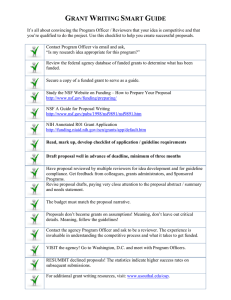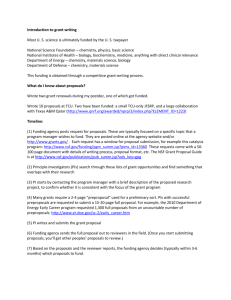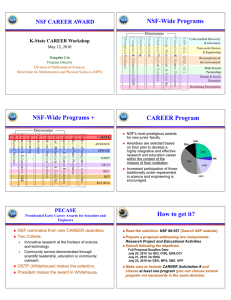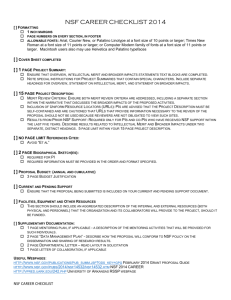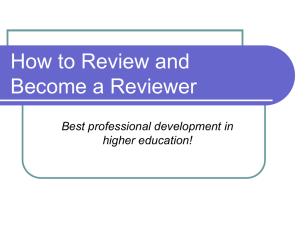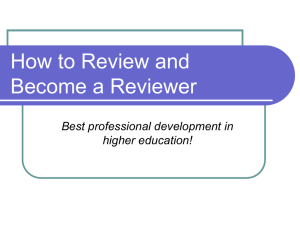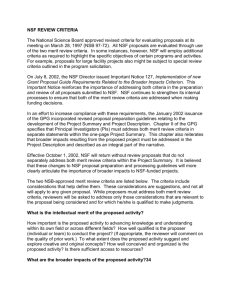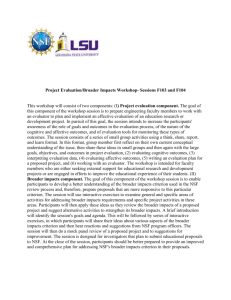Funding Strategy Workshop - Research
advertisement
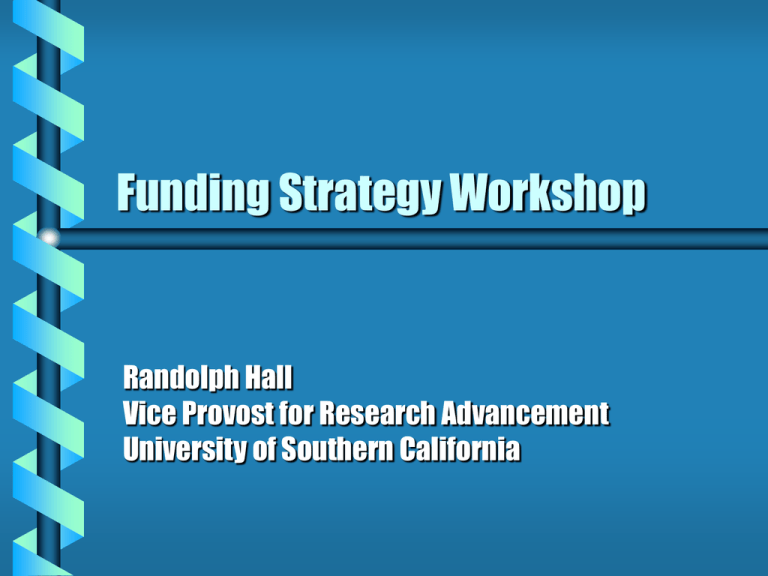
Funding Strategy Workshop Randolph Hall Vice Provost for Research Advancement University of Southern California Why Funding? Enables research Attracts Ph.D. students Can build collaborations, increase exposure Measure of quality Helps school -- overhead and student support, which provides growth Can help in promotion Can add to income through summer salary, or can relieve teaching Funding Cautions Develop coherent research program Do not distract from publications or other creative endeavors Continuity of support Effort should not be overwhelming Better to pass an opportunity, than to embark on one with little chance of success Be prepared for rejection Creating the Strategy Set your own vision: what do you want to be known for 5 years from now • Assess your own capabilities and passions for research • Identify capabilities that you can leverage here at USC -- do not become isolated • Create milestones needed for tenure More Strategy Assess the Market • Identify agencies and programs that fund related research • Determine how your vision can be crafted to match funding priorities • Create a proposal writing schedule Exercise Imagine you are writing your personal statement for tenure promotion, five years for now: describe your area of research and accomplishments as though you have already achieved them Assess: how critical is funding in fulfilling your vision Next Steps in Securing Funding 1. Identify relevant funding agencies 2. Research the programs 3. Get to know the program officer 4. Write a responsive proposal 5. Get feedback and revise 1. Identify relevant agencies Goal: find the sources of funding Contact your peers, mentors, at USC and elsewhere Find out where other universities get funding in your area Attend relevant conferences Search the web 2. Research the programs Goal: determine priorities and selection process Read material on the web • Program priorities, who has been funded and for what, review process; who decides and how peer review is conducted; total dollars; size and duration of awards; success rate Contact program officer • What is the real story on funding; obtain suggestions on how to structure proposal; volunteer to be on review panel Contact other people who have been funded • What did it take for them to get funded; get example of a funded proposal 3. Get to Know the Program Officer Goal: Make your research a priority within the program Visit and meet in person; present your ideas and get feedback; find out what the program officer cares most about; find out & influence what will happen in future Volunteer to serve on a review panel Try to connect to program officer through conferences, professional meetings Treat him or her like a customer 4. Write a Responsive Proposal Goal: Be responsive, innovative and communicate well Parse the RFP; make sure that you have addressed all requirements Write the proposal for the audience (understand who are the reviewers) Create an appropriate budget and plan Excel in all categories 4a. Develop Concept Understand literature and needs Build from your strengths Identify/develop partners Reaction from colleagues and peers 4b. Writing Follow section format exactly Clear statement of benefits and significance: in abstract, introduction, conclusions Complete review of relevant literature Include clear schedule, and describe the deliverables Justify budget expenditures Present your qualification 5. Get Feedback and Revise Goal: Make sure you got it right Complete proposal at least 3 weeks before deadline Show proposal to a peer who knows your area of work well Show proposal to a peer who is not a specialist in your area Show proposal to a non-researcher Proposal Writing A good research proposal demonstrates innovation and significance within its field of study Myths of Proposal Writing Technical and scientific merits alone determine winners Proposals should always be written for the top experts in your field Only peers pick proposals Don’t ask your colleagues to review your proposal -- they won’t appreciate it anyway More Myths It’s a good idea to submit the same proposal to several agencies Follow your own writing style -- reviewers don’t care about the guidelines Don’t worry about schedules and deliverables -- this is research Reality Reviewers often do not read proposals carefully, and they frequently look for the “big idea” Reviewers also look for reasons to deny proposals -- there should be no holes Reviewers are not always experts Managers make the final decision, and influence the process What Peers Want Innovation and significance Responsiveness to program Care in writing proposal Capability to accomplish objectives What Managers Want Proposals that fulfill programmatic priorities Complementary work (no duplication) Investigators who are good to work with No black marks (always deliver on promises) Summary Begin with innovation and significance Treat programs like customers -- you need to be responsive Get as much feedback as possible -- avoid risks -- you can raise the probability of being picked Summary Should do Exactly What is Asked Project Summary: Summarize the integrated education and research activities of the proposed CAREER project. Note that the Project Summary must clearly address in separate statements how the proposal meets both the Intellectual Merit and Broader Impact review criteria. Project Description Well-argued and specific proposal for activities that will, over a 5year period, build a firm foundation for a lifetime of contributions to integrated research and educational activities in the context of the PI's organization. Note that the Project Description may not exceed 15 pages. Should Include: a description of the proposed research project, including preliminary supporting data where appropriate, specific objectives, methods and procedures to be used, and expected significance of the results; a description of the proposed educational activities, including plans to evaluate their impact; a description of how the research and educational activities are integrated with one another; and results of prior NSF support, if applicable. Education Proposed education activities may be in a broad range of areas and may be directed to any level: K-12 students, undergraduates, graduate students, and/or the general public, but should be related to the proposed research. Some examples are: designing innovative courses or curricula; supporting teacher preparation and enhancement; conducting outreach and mentoring activities to enhance scientific literacy or involve students from groups that have been traditionally underrepresented in science; researching pedagogy or students' learning and conceptual development in the discipline; incorporating research activities into undergraduate courses; linking education activities to industrial, international, or cross-disciplinary work; and implementing innovative methods for evaluation and assessment. Education activities may also include designing new educational materials and practices or adapting and implementing effective educational materials and practices developed elsewhere. Such activities should be consistent with research and best practices in curriculum, pedagogy, and evaluation. A helpful document for information on NSF programmatic goals for evaluating education activities is the NSF publication The 2002 User-Friendly Handbook for Project Evaluation (NSF 02-057). Proposal Outline Summary • • Intellectual Merit Broader Impact Project Description • • Introduction Research Plan – – – – – • Objectives Review of prior research Supporting data Methods and procedures Expected results Education Plan – Activities – Assessment – Integration or Research and Education • • Budget and Schedule Conclusions Intellectual Merit How important is the proposed activity to advancing knowledge and understanding within its own field or across different fields? How well qualified is the proposer (individual or team) to conduct the project? (If appropriate, the reviewer will comment on the quality of the prior work.) To what extent does the proposed activity suggest and explore creative and original concepts? How well conceived and organized is the proposed activity? Is there sufficient access to resources? Broader Impacts How well does the activity advance discovery and understanding while promoting teaching, training, and learning? How well does the proposed activity broaden the participation of underrepresented groups (e.g., gender, ethnicity, disability, geographic, etc.)? To what extent will it enhance the infrastructure for research and education, such as facilities, instrumentation, networks, and partnerships? Will the results be disseminated broadly to enhance scientific and technological understanding? What may be the benefits of the proposed activity to society? Integration of Research and Education One of the principal strategies in support of NSF's goals is to foster integration of research and education through the programs, projects, and activities it supports at academic and research institutions. These institutions provide abundant opportunities where individuals may concurrently assume responsibilities as researchers, educators, and students and where all can engage in joint efforts that infuse education with the excitement of discovery and enrich research through the diversity of learning perspectives. Diversity Broadening opportunities and enabling the participation of all citizens -- women and men, underrepresented minorities, and persons with disabilities -- is essential to the health and vitality of science and engineering. NSF is committed to this principle of diversity and deems it central to the programs, projects, and activities it considers and supports. Exercise 2 A) Complete steps 1 and 2 for a funding program of your choice B) Parse a request for proposal – create the outline
